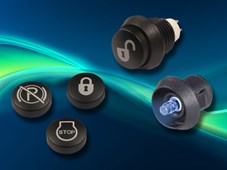Design Requirements On Pushbutton Switches
 By Edward Mork | April 28, 2021
By Edward Mork | April 28, 2021

Switches have been evolving to provide solutions and to meet your products’ design requirements – Pushbutton series
Switches are the primary interface when powering devices, triggering relays, selecting functions or enabling a myriad of human/machine interfaces. Depending on the application, the switch may or may not be seen, and may not directly be felt. In these aspects C&K's emphasis on innovation and Quality in switch solutions through appearance, feel, performance, and even sound make a significant difference.
The design, materials, contact construction, actuation type and mounting all help determine whether the switch will last 50,000 operating cycles or over 1 million. C&K continues to deliver innovative switch solutions through various technologies. In the end, our goal is that the user should continually have a positive experience with the switch’s feel, appearance, performance and result.
Several key engineering characteristics must be evaluated when selecting a switch to be sure it can perform the desired functions. Most important among these constraints is electrical performance ratings. The criteria for a switch include the current rating, voltage rating and contact resistance. The switch manufacturer will specify these ratings, which are determined by such factors as contact size, contact material and contact spacing. Plating erosion is another element that must be considered because it can lead to premature high contact resistance. The current rating of a switch refers to the maximum current the switch is designed to carry. The current rating should not be exceeded. If it does, it may not be able to open the circuit.
The voltage rating of a switch refers to the maximum voltage allowable in the circuit in which the switch is used. The voltage rating may be given as an AC voltage, a DC voltage, or both. If a voltage higher than the voltage rating of the switch is applied to the switch, the voltage may be able to "jump" the open contacts of the switch. This would make it impossible to control the circuit in which the switch is used. More voltage with the same current will do more damage to the contact and shorten the switch life. Contacts are available in the rating ranges of few milli-amp to 6A with multiple poles and throws with various combination of configurations like our offering in the 8020, PN, PHB, PBA, F & NE18 series and more.
For design engineers, every harsh environment presents its own set of challenges stemming from a host of factors, such as extreme temperatures, water, chemicals, dust, oil and other types of contaminants. A key characteristic of heavy equipment environments is that prolonged or particularly obtrusive exposure to contaminants is a certainty. These conditions also often present temperature and vibration concerns, which could affect the fit and performance of the switch.
Construction, mining, and agriculture sites are not the most forgiving of environments for electrical components. When selecting a switch for an in-cab heavy equipment application, installing a product not designed for harsh environmental conditions can result in dramatically decreased switch life expectancy and even critical switch failure.
As such, IP-rated switches are the best choice for heavy equipment applications. IP-rated switches are guaranteed to be resistant to certain environmental factors based on a ratings classification system. The IP code is part of the International Organization for Standardization’s (ISO) IEC60529 standard. The first digit of the IP code indicates the level of protection that the enclosure provides against access to hazardous parts (e.g., electrical conductors, moving parts) and the ingress of solid foreign objects. The second digit covers liquids. Our products within the pushbutton family can meet these requirements are: AP, APB, NP, PNP, ATP and PLP16 line.
Engineers should select a switch that not only fits size and performance parameters, but is also user-friendly. Not everyone that operates heavy machinery is a native speaker of English so cap symbols are important as is the ability to customize these symbols. Similarly, the switches are easy to operate with one hand and robust enough to withstand the repetitive maneuvers related to a typical function.
Illuminated switches are commonly used in applications located in poorly lit environments (e.g., dimly lit vehicle cabins), which can make it difficult to identify individual switch function, so the backlit cap graphics will provide operators with a highly visible indication of what they’re activating before they turn it on. They also have distinct feedback that can be felt through thick work gloves. These features are commonly available as choices in the AP, APB, ATP/ATPS, KLS, PLP16 & Elum series.
C&K’s rich legacy in Industrial and off-road transportation applications, along with its vast portfolio and resources ensure the highest standards in function and performance. Please click here: Product Flow Chart or visit our C&K website to learn more on our Pushbutton product offering.
